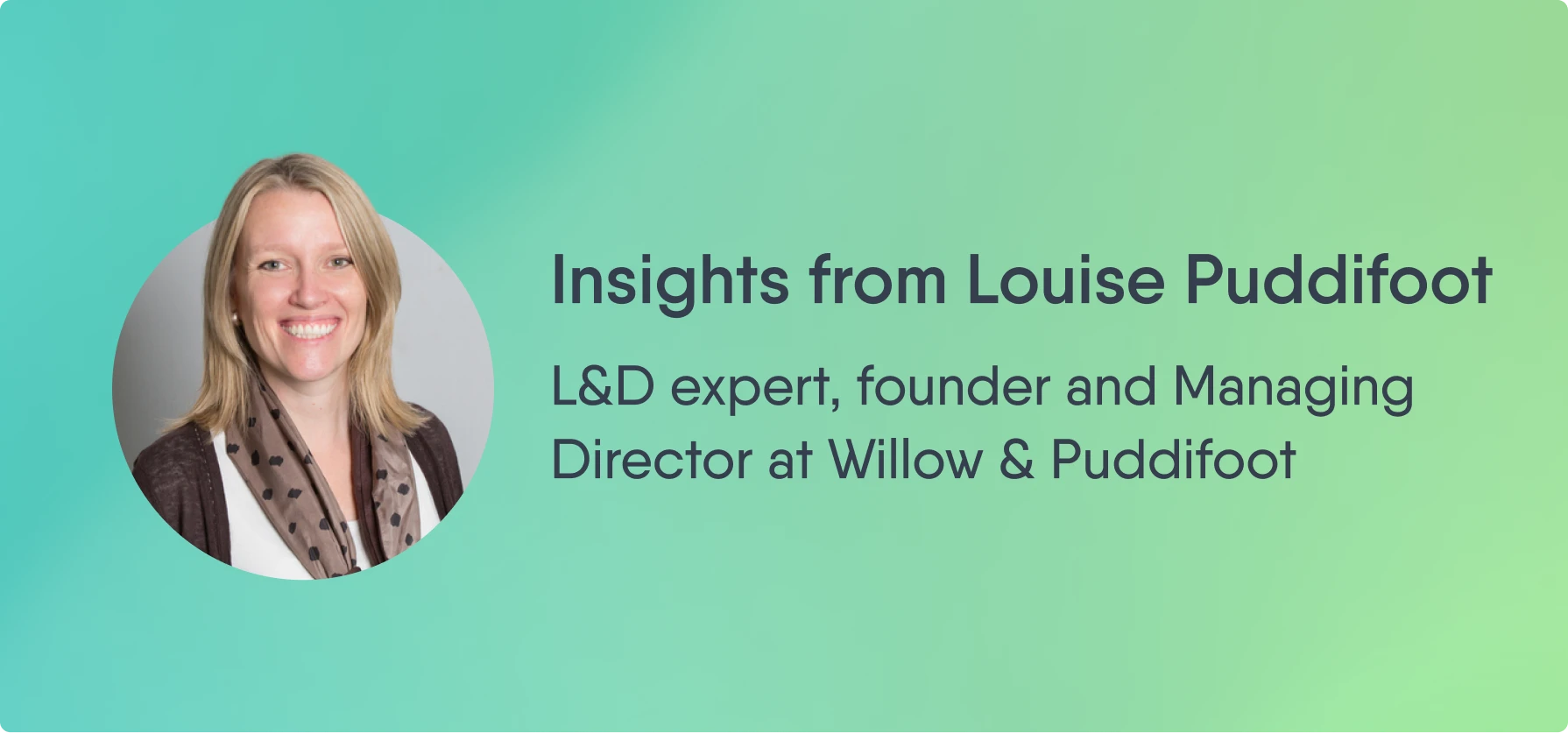How to determine the ROI of Employee-generated Learning (EGL)
Facing the task of showcasing your EGL initiative’s value? Louise Puddifoot, who implemented EGL at Nielsen, shares insights into navigating these waters.

Louise Puddifoot is an L&D expert who now leads her own training and development company, Willow & Puddifoot. Before that, she spent a decade at Nielsen, culminating in her role as Vice President of Talent Development. During that time, she spearheaded the adoption of Employee-generated Learning (EGL) via Easygenerator.
Why EGL and Easygenerator?
Keeping up with training needs
Louise’s L&D team at Nielsen turned to EGL to meet the longtail of needs for training that the central L&D team couldn’t fulfill due to capacity limits. While the L&D team could address strategic priorities aimed at large audiences, many team-specific or business unit-specific needs remained unmet. So, they sought a solution that empowered teams to meet their own specialized training needs.
Cultivating a learning culture
Another driving force for Louise’s team was the desire to foster a culture of learning and knowledge sharing, aiming to retain critical business knowledge within the organization.
Expectations for ROI calculation
Louise clarifies that while they didn’t set out with a numeric ROI target, the aim was clear: to make the business self-sufficient in generating its learning content. A significant measure of success was the anticipated reduction in content creation requests to the central L&D team.
Understanding the initial investment
Aside from the obvious licensing costs, a key part of the investment in EGL involved dedicating some of the central team members’ roles to supporting and rolling out the platform. Louise explains, “It was about assigning the right people, not calculating man-hours.”
Although no direct unforeseen costs emerged, the EGL initiative prompted a review and improvement of processes for loading e-learning courses onto the LMS. This realization led to a side project to improve the overall L&D ecosystem.
Calculating the ROI of EGL
Establishing value beyond numbers
Without deriving a specific ROI figure, Louise’s team adopted a holistic approach to measuring the value of EGL. They created a dashboard that offered insights into the use and impact of content created through Easygenerator. The dashboard focused on “Reach, Resonance, and Reaction”:
- Reach measures the extent and specific audience engagement with learning content, ensuring it targets and is utilized by the intended groups. (How many e-learnings created? On which topics? Who’s taken each e-learning?)
- Resonance evaluates learners’ satisfaction and the perceived value of the content through feedback and scoring systems. (Did learners like the course? How did they score?)
- Reaction varies by project and is only analyzed for some projects; it assesses the direct impact of learning on business outcomes.
For select projects, they enriched these dashboard metrics with both project-specific metrics and qualitative success stories that illustrate the learning’s effectiveness in real-world scenarios.
Calculating savings and time efficiency
A significant aspect of expressing ROI involved three things:
- estimating savings from reduced vendor costs
- the efficiency gained from peer training
- increasing training output without hiring more instructional designers
A practical strategy is asking authors to compare the hours they dedicated to traditional, face-to-face teaching against the time it took them to create an e-learning course on the same topic.
Realizing the benefits
Gaining efficiency and independence
Nielsen’s adoption of EGL and Easygenerator empowered its business units to operate independently, simplifying content updates and customization. The ability to duplicate and tailor e-learnings for different teams or regions significantly enhanced operational efficiency.
Fostering a knowledge-sharing culture
Beyond tangible benefits, EGL fostered a culture of knowledge sharing, ensuring valuable insights remained within the organization. This shift towards a repository of organizational knowledge is among the intangible benefits that, while challenging to quantify, are invaluable to the business.
Louise’s advice for L&D professionals
Don’t get hung up on calculating a precise ROI figure. Instead, focus on the strategic impact and alignment with business objectives. Don’t just look at numbers or a dashboard but also collect success stories from employees.
Louise remarks, “We found that a mixture of numbers and human stories works really well to communicate the impact to the business. Because while senior stakeholders want numbers and evidence, they connect with the story. They remember the story.”
One example is the story of a senior data analyst, Sarah. Sarah was frequently asked to explain the advanced analytics for a key service on a one-to-one basis, which cost her a lot of time. She created a simple e-learning with easy-to-understand examples and interactive exercises. As a result, the team’s proficiency in these analytics improved, resulting in more efficient and accurate delivery of related projects. And it saved Sarah a lot of time.
Louise also advises collaborating with senior stakeholders to align training initiatives with business goals. This will ensure that your EGL efforts resonate with broader organizational objectives.
Conclusion
Calculating the ROI of your EGL initiative—like all training initiatives—is way more nuanced than crunching numbers. It involves a holistic assessment of strategic impacts, efficiency gains, and cultural shifts towards knowledge sharing.
By embracing a collaborative approach with stakeholders and focusing on what truly matters to the business, you can navigate the challenges of demonstrating EGL’s value and its alignment with business goals.
-
 14 day trial with access to all features. Start with variety of course templates.
14 day trial with access to all features. Start with variety of course templates. -
 Get unlimited design inspirations. Level up your courses.
Get unlimited design inspirations. Level up your courses. -
 Upload your PowerPoint presentations. Get instant courses created.
Upload your PowerPoint presentations. Get instant courses created.




